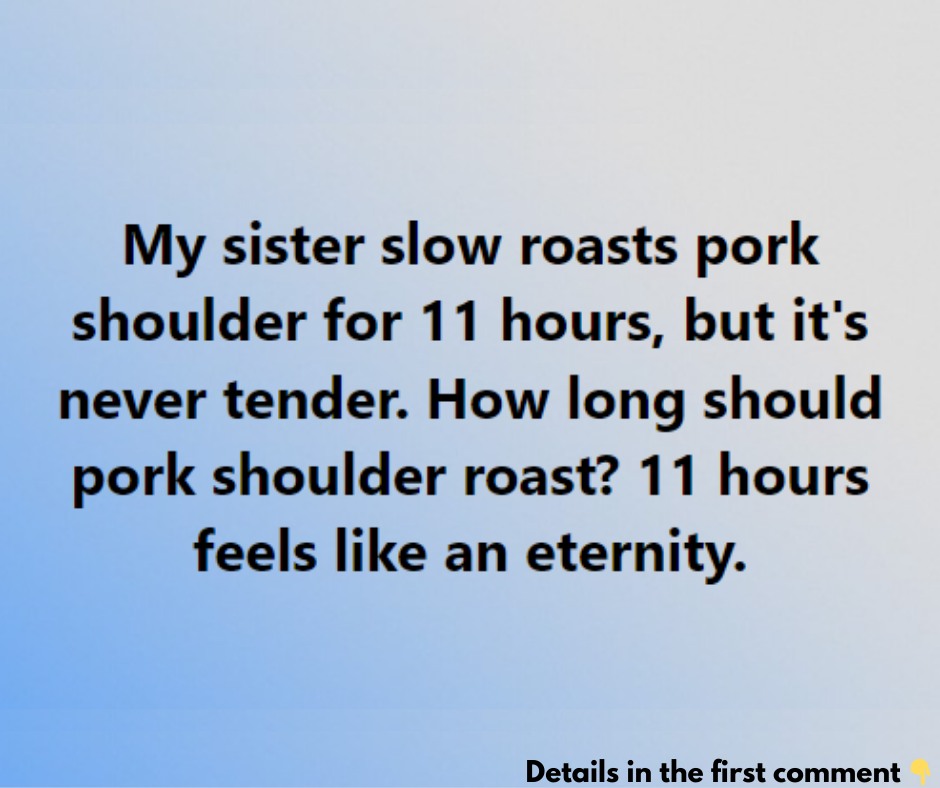My sister has been slow-roasting pork shoulder for 11 hours, yet it’s never tender enough. If you’ve ever wondered why your pork roast is still tough after what feels like an eternity, you’re not alone. The process of slow-roasting pork shoulder, while time-honored, can be tricky. It’s not just about the hours you put into it—it’s about understanding the right balance of temperature, timing, and technique.

In this article, we’ll dive into the science behind slow-roasting pork shoulder, key factors that impact tenderness, and how long it really should take to get that perfectly soft, pull-apart pork.
The Science Behind Slow-Roasting Pork Shoulder
Pork shoulder, sometimes called pork butt, is a tough, fatty cut of meat that needs slow cooking to break down its connective tissues. The goal is to apply steady, low heat over several hours to melt the fat and convert the connective tissues into gelatin. This process leaves the meat tender and juicy.
While 11 hours might seem like plenty of time to achieve this, there are other critical elements at play that might be affecting the result. To get that perfect tenderness, let’s break down the most important aspects.
1. The Right Oven Temperature
One of the most common reasons pork shoulder turns out tough, even after a long cooking time, is using the wrong oven temperature. If the oven is too hot, the outside of the pork can cook too quickly and dry out before the collagen in the meat has a chance to break down. Conversely, if the temperature is too low, the pork may not cook evenly.
The ideal range for slow-roasting pork shoulder is between 225°F and 275°F (107°C to 135°C). This low and slow approach ensures that the fat renders properly and the connective tissues soften, resulting in tender meat. Using an oven thermometer can help ensure your oven holds a consistent temperature.
2. Heat Consistency Matters
An oven that fluctuates in temperature can be a major factor in uneven cooking. If your oven isn’t holding a steady heat, certain areas of the pork might cook faster than others, leaving some parts tough while others are overcooked. If you suspect your oven temperature fluctuates, checking its calibration or using a reliable oven thermometer can make a big difference.
3. Quality of Meat and Preparation
The quality of the pork shoulder also plays a role in the final result. If the cut is too lean, it won’t have enough fat to break down during cooking, resulting in tougher meat. Additionally, if the pork shoulder isn’t brought to room temperature before roasting, it can throw off the cooking time. For the best results, consider brining or seasoning the meat before cooking to help with both tenderness and flavor.
How Long Should You Roast Pork Shoulder?
While time is an important factor, it’s not the only indicator of doneness. The size of the pork shoulder and the temperature at which it’s cooked play key roles in determining how long it should roast.
- At 225°F (107°C): Roasting at this low temperature requires about 1.5 to 2 hours per pound of pork. For an 8-pound pork shoulder, this could mean anywhere from 12 to 16 hours. While long, this method ensures the fat and connective tissues break down slowly.
- At 250°F (121°C): This will speed up the cooking process slightly, with a cooking time of about 1 to 1.5 hours per pound. So, an 8-pound pork shoulder would take around 8 to 12 hours.
- At 275°F (135°C): Roasting at this higher temperature further reduces cooking time. You can expect about 1 hour per pound, which means an 8-pound pork shoulder should take roughly 8 hours.
Remember, these are general guidelines. The most reliable way to determine doneness is by using a meat thermometer to check the internal temperature of the pork.
Tips for a Tender Pork Shoulder
If after 11 hours your pork shoulder still isn’t tender, here are a few expert tips to make sure your next roast is perfect:
- Use a Meat Thermometer: The internal temperature of the pork shoulder should be between 195°F and 205°F (90°C to 96°C) to ensure the collagen has fully broken down, resulting in tender meat.
-





